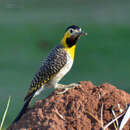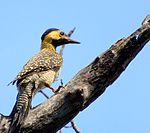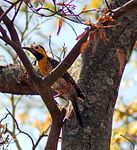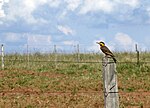pt-BR
nomes no trilho de navegação


Colaptes campestris ye un carpinteru grande qu'habita en sabanes tropicales y semitropicales del centru de Suramérica, especialmente de la ecorrexón del Cerrado.
Mide unos 32 cm de llargu, con llombu y ales marrones llistaes de blancu, y el pechu mariellu.
Habita zones de sabanes y carba. Distribuyir en Surinam, nel centru y nordeste del Brasil, nel centru y este de Bolivia, en gran parte del Paraguái y nel nordeste de l'Arxentina, nel estremu norte de la provincia de Misiones, na rexón mesopotámica de dichu país.[2]
Escontra'l sur ye reemplazáu por Colaptes campestroides, con quien forma una superespecie.
 Esta páxina forma parte del wikiproyeutu Aves, un esfuerciu collaborativu col fin d'ameyorar y organizar tolos conteníos rellacionaos con esti tema. Visita la páxina d'alderique del proyeutu pa collaborar y facer entrugues o suxerencies.
Esta páxina forma parte del wikiproyeutu Aves, un esfuerciu collaborativu col fin d'ameyorar y organizar tolos conteníos rellacionaos con esti tema. Visita la páxina d'alderique del proyeutu pa collaborar y facer entrugues o suxerencies. Colaptes campestris ye un carpinteru grande qu'habita en sabanes tropicales y semitropicales del centru de Suramérica, especialmente de la ecorrexón del Cerrado.
Colaptes campestris[1] a zo ur spesad evned eus ar c'herentiad Picidae.
Anvet e voe Picus campestris (kentanv) da gentañ-penn (e 1818) gant an evnoniour gall Louis Jean Pierre Vieillot (1748-1831).
Ar spesad a gaver an daou isspesad anezhañ[2] e Suamerika :
a vo kavet e Wikimedia Commons.
Colaptes campestris a zo ur spesad evned eus ar c'herentiad Picidae.
Anvet e voe Picus campestris (kentanv) da gentañ-penn (e 1818) gant an evnoniour gall Louis Jean Pierre Vieillot (1748-1831).
El picot campestre[1] (Colaptes campestris) és un gran picot sud-americà de la família dels pícids.
Mesura uns 32 cm de llarg, amb esquena i ales marrons llistades de blanc, i el pit groc.
Habita zones de pasturatges, savanes i matoll i pot ser trobat a l'Argentina, Bolívia, Brasil, Paraguai, Suriname i Uruguai.
El picot campestre (Colaptes campestris) és un gran picot sud-americà de la família dels pícids.
Mesura uns 32 cm de llarg, amb esquena i ales marrons llistades de blanc, i el pit groc.
Habita zones de pasturatges, savanes i matoll i pot ser trobat a l'Argentina, Bolívia, Brasil, Paraguai, Suriname i Uruguai.
Aderyn a rhywogaeth o adar yw Ysgytiwr y campo (sy'n enw benywaidd; enw lluosog: ysgytwyr y campo) a adnabyddir hefyd gyda'i enw gwyddonol Colaptes campestris; yr enw Saesneg arno yw Campo flicker. Mae'n perthyn i deulu'r Cnocellod (Lladin: Picidae) sydd yn urdd y Piciformes.[1]
Talfyrir yr enw Lladin yn aml yn C. campestris, sef enw'r rhywogaeth.[2] Mae'r rhywogaeth hon i'w chanfod yn Ne America.
Mae'r ysgytiwr y campo yn perthyn i deulu'r Cnocellod (Lladin: Picidae). Dyma rai o aelodau eraill y teulu:
Rhestr Wicidata:
rhywogaeth enw tacson delwedd Cnocell fraith Japan Yungipicus kizuki Cnocell gorunfrown Yungipicus moluccensis Cnocell lwyd fawr Mulleripicus pulverulentus Cnocell lwydaidd Mulleripicus fulvus Corgnocell Temminck Yungipicus temminckii Pengam Jynx torquilla Pengam gyddfgoch Jynx ruficollisAderyn a rhywogaeth o adar yw Ysgytiwr y campo (sy'n enw benywaidd; enw lluosog: ysgytwyr y campo) a adnabyddir hefyd gyda'i enw gwyddonol Colaptes campestris; yr enw Saesneg arno yw Campo flicker. Mae'n perthyn i deulu'r Cnocellod (Lladin: Picidae) sydd yn urdd y Piciformes.
Talfyrir yr enw Lladin yn aml yn C. campestris, sef enw'r rhywogaeth. Mae'r rhywogaeth hon i'w chanfod yn Ne America.
Der Feldspecht (Colaptes campestris), gelegentlich auch Camposspecht genannt, ist eine Art aus der Gattung der Goldspechte (Colaptes) innerhalb der Unterfamilie der Echten Spechte. Die Art ist monotypisch. Der früher als Unterart angesehene Colaptes c. campestroides wurde 2014 mit dem deutschen Namen Pampaspecht in Artrang gestellt.
Der knapp grauspechtgroße Vogel hat ein ausgedehntes Verbreitungsgebiet im zentralen und südöstlichen Südamerika, wo er sich vor allem von verschiedenen Ameisenarten und Termiten ernährt, die er vorwiegend am Boden erbeutet. Die Art lebt oft in kleinen Gruppen. Der Feldspecht ist in seinem Verbreitungsgebiet regional sehr häufig und wird von der IUCN als ![]() (=least concern – nicht gefährdet) eingestuft.
(=least concern – nicht gefährdet) eingestuft.
Mit maximal 31 Zentimetern Körperlänge und einem Gewicht von bis zu 192 Gramm entspricht die Art in Bezug auf Größe und Masse in etwa dem Grauspecht. In seinem Verbreitungsgebiet ist er allgemein bekannt und kann mit keiner anderen Spechtart verwechselt werden. Die beiden sehr nahe verwandten und häufig hybridisierenden Arten Feldspecht und Pampaspecht unterscheiden sich deutlich vor allem in Färbung von Kehle, Stirn und Hals.
Auf kastanienfarbenem bis grauschwarzem Grund ist die gesamte Oberseite deutlich und eng weiß bis cremefarben gebändert und gefleckt. Diese Bänderung ist an den Schultern und auf den großen Flügeldecken breiter als am Rücken. Die Schwingen sind dunkelbraun; sie weisen eine schmale, hellbräunliche bis weiße Bänderung auf. Der lange Schwanz ist auf der Oberseite schwarzbraun. Die Außenfahnen der äußeren Federn sowie die gesamten inneren Steuerfedern sind weiß bis cremefarben gebändert. Die Unterseite ist von der Brust bis zum Steiß auf weißlichem, gelb behauchtem Grund deutlich schwärzlich pfeilspitzenartig gezeichnet. Die Flügelunterseite ist gelblich, die Flügelränder und die Flügelspitze ist dunkel gezont. Die Unterflügeldecken weisen dunkle Markierungen auf. Die Unterseite des Schwanzes ist etwas blasser als dessen Oberseite, die helle Bänderung ist undeutlicher.
Der Kopf ist von der Stirn bis zum Nacken schwarz; die etwas verlängerten Nackenfedern können einen angedeuteten Schopf bilden. Der Zügel und die Region um die Augen ist cremefarben, die Ohrdecken, der Nacken und die obere Brustregion sind auffallend und intensiv dunkel goldorange gefärbt und weist zum Bauch hin oft eine rötlichorange Tönung auf. Die Kehle ist auf schwarzem Grund ganz fein weiß gezeichnet. An der Schnabelbasis beginnt beim Männchen ein individuell unterschiedlich stark ausgebildeter scharlachroter Bartstreif und begrenzt zu den Ohrdecken hin die schwarze Kehlfärbung. Beim Weibchen ist der Bartstreif auf schwarzem Grund mit weißen Einschlüssen marmoriert.
Der lange, spitze, abwärts gebogene Schnabel ist schwarz, manchmal zur Spitze hin auch rötlichbraun. Die Füße und die vier Zehen sind variabel grünlichgrau bis fleischfarben. Die Augen sind kastanien- bis rötlichbraun.
Bis auf die erwähnte Zeichnungsdifferenz im Malarbereich unterscheiden sich die Geschlechter in Bezug auf ihre Färbung nicht. Weibchen scheinen jedoch um die 10 Prozent leichter als Männchen zu sein.[1] Jungvögel sind blasser als adulte, besonders die Goldfärbung der Wangen ist bei ihnen weniger intensiv.
Der Feldspecht ist sehr ruffreudig. Häufigster Ruf ist ein zwei- oder dreisilbiger Pfiff, bei dem die einzelnen Silben stark miteinander verschmelzen. Wiiik oder kiip-Rufreihen dienen der Revierabgrenzung. Daneben verfügt die Art über eine Reihe wiehernd oder zittrig klingender Lautäußerungen. Im Gruppenkontakt sind wick…wick…wick Rufreihen zu hören.
Der Feldspecht ist im zentralen östlichen und südöstlichen Südamerika weit verbreitet. Das weitgehend geschlossene Verbreitungsgebiet erstreckt sich von Ostbrasilien südwärts bis Paraguay und westwärts bis zur östlichen Andenabdeckung in Bolivien. Zusätzlich bestehen Verbreitungsinseln in Suriname und am unteren Amazonas. Auch einige der Küste vorgelagerte Inseln werden von der Art bewohnt. Der Feldspecht profitiert von der zunehmenden Entwaldung seines Lebensraumes und breitet sich vor allem entlang der großen Fernstraßen weiter nach Westen aus.
Die Art besiedelt offenes Land mit einzeln stehenden Bäumen, insbesondere Pampa und semiaride Buschsteppen (Caatinga), daneben größere Kahlschlaggebiete, wie sie entlang der Straßenbauprojekte entstehen, Weideland, Waldränder und Plantagen. Wesentlich sind Nistbäume und ein ausreichendes Angebot an Ameisen und Termiten. Die Art kommt vom Meeresniveau bis in Höhen über der regionalen Baumgrenze vor. In Zentralargentinien befinden sich die höchstgelegenen Brutgebiete bei 600 Metern.[1]
Feldspechte ernähren sich vor allem von Ameisen und Termiten. Auch größere Käfer und Grillen werden erbeutet. Gelegentlich öffnet er die Nester von Töpfervögeln und frisst deren Eier und Nestlinge.
Feldspechte ernähren sich hauptsächlich von bodenlebenden Insekten, beobachten ihre Umgebung aber häufig von erhöhten Standorten. Oft sind sie bei der Nahrungssuche in kleinen Gruppen versammelt, häufig auch mit dem nahe verwandten Grünbindenspecht (Colaptes melanochloros) vergesellschaftet, der häufiger als der Feldspecht die niedrige Ast- und Stammregion zur Nahrungssuche aufsucht.[2] Feldspechte öffnen mit ihrem Schnabel die Gänge bodenbewohnender Ameisen und Termiten, sammeln diese Tiere von der Erdoberfläche auf, wenden mit schnellen Schnabelbewegungen Blätter und lesen Insekten von deren Unterseite ab, hacken aber auch mit Schnabelhieben Termitenbauten auf. Die aufgebrochenen Termitenbauten werden vom Riesentukan regelmäßig als Bruthöhlen genutzt.[3] Bei der Nahrungssuche schreiten sie, längere Distanzen legen sie hüpfend zurück. Feldspechte hämmern gelegentlich Höhlen mit einem Durchmesser von etwa 7 Zentimeter in Gebäude. Ob es sich dabei um Schlafhöhlen oder Futterspeicher handelt, ist bislang unklar.[1]
Auf Grund der erheblichen Nord-Süd-Ausdehnung des Verbreitungsgebietes der Art variieren die Brutzeiten stark. Die Brutsaison beginnt in Surinam bereits im Januar und endet bei den südlichsten Populationen Argentiniens im November. Während dieser Zeit werden die Spechte vor allem in kleinen Gruppen beobachtet, was auf eine gewisse Form einer sozialen Brutorganisation schließen lässt. Genauere Informationen der Beziehungen der Gruppenmitglieder zueinander liegen jedoch bislang nicht vor. Die Art brütet nicht in dichten Kolonien, 5–6 Nester innerhalb eines Abstands von 100 Metern wurden jedoch beobachtet.[4]
Die Bruthöhle wird in unterschiedlicher Höhe (> 12 Meter) in lebende, bevorzugt aber absterbende oder tote Bäume oder Baumstümpfe geschlagen, auch Telegraphenmasten oder Holzkonstruktionen werden verwendet. Gelegentlich hämmern Feldspechte ihre Höhlen in die Nester baumbewohnender Termiten, in baumlosen Gegenden auch in Termitenbauten oder graben Bruthöhlen in Uferböschungen.
Das Gelege besteht aus 4–5 Eiern; es wird von beiden Eltern erbrütet. Über die Brutdauer und die Nestlingszeit liegen keine Angaben vor. Nach dem Ausfliegen der Jungvögel scheint der Familienverband noch relativ lange erhalten zu bleiben.
Der Feldspecht ist eine von 19 mittelgroßen Spechtarten der Gattung Colaptes, die vor allem in Mittel- und Südamerika verbreitet sind. Die Verwandtschaftsbeziehungen der Gattung zu anderen Gattungen der Picinae sind noch nicht ausreichend erforscht.
Der lange als conspezifisch aufgefasste Colaptes c. campestroides wird seit 2014 als eigenständige Art Colaptes campestroides geführt. Sein Verbreitungsgebiet schließt südlich an das des Feldspechtes an. In Paraguay, im südlichen Brasilien und möglicherweise auch im nördlichen Argentinien besteht ein unterschiedlich breites Gebiet, in dem beide Arten gemeinsam vorkommen. Hier werden häufig Mischbruten beobachtet. Die Hybride weisen offenbar keine genetischen Defizite auf.[5]
Das Gesamtverbreitungsgebiet dieser Art wird auf fast 6 Mio Quadratkilometer geschätzt. Die Art scheint bislang von jenen Eingriffen in den Naturraum zu profitieren, die offene, nur einzeln baumbestandene Landschaftsstrukturen schaffen. Sie kann daher ihr Areal ausdehnen und nimmt im Bestand zu. Quantitative Bestandseinschätzungen sind nicht verfügbar. Laut IUCN ist sie ungefährdet (least concern).
Der Feldspecht (Colaptes campestris), gelegentlich auch Camposspecht genannt, ist eine Art aus der Gattung der Goldspechte (Colaptes) innerhalb der Unterfamilie der Echten Spechte. Die Art ist monotypisch. Der früher als Unterart angesehene Colaptes c. campestroides wurde 2014 mit dem deutschen Namen Pampaspecht in Artrang gestellt.
Der knapp grauspechtgroße Vogel hat ein ausgedehntes Verbreitungsgebiet im zentralen und südöstlichen Südamerika, wo er sich vor allem von verschiedenen Ameisenarten und Termiten ernährt, die er vorwiegend am Boden erbeutet. Die Art lebt oft in kleinen Gruppen. Der Feldspecht ist in seinem Verbreitungsgebiet regional sehr häufig und wird von der IUCN als ![]() (=least concern – nicht gefährdet) eingestuft.
(=least concern – nicht gefährdet) eingestuft.
The campo flicker (Colaptes campestris) is a species of bird in subfamily Picinae of the woodpecker family Picidae.[3] It is found in Argentina, Bolivia, Brazil, Paraguay, Suriname, and Uruguay.[4]
The campo flicker was originally described as Picus campestris.[5]
The American Ornithological Society, the International Ornithological Committee, and the Clements taxonomy assign two subspecies to the campo flicker: the nominate C. c. campestris (Vieillot, 1818) and C. c. campestroides (Malherbe, 1849).[6][3][7] Since the early 1900s various authors have treated subspecies C. c. campestroides as a separate species, calling it the "field flicker" or "pampas flicker". BirdLife International's Handbook of the Birds of the World (HBW) continues to do so as the pampas flicker.[8]
The campo flicker is about 30 cm (12 in) long and weighs about 150 g (5.3 oz). Males and females have the same plumage except on their faces; males have a red malar stripe and females a black one. Adults of both subspecies have a black crown and a yellow face with white around the eye. Subspecies campestris has a black throat and campestroides a white one, their only difference. Both subspecies' upperparts are brown with dull white bars; their rump is white with a few narrow dark bars. Their flight feathers are brown with yellow shafts. The top side of their tail is black; the central and outermost feathers have thin paler bars. Their tail is brown with white bars on the outermost feathers. Their underparts are white with brown bars. Their long bill is gray, their iris reddish brown, and the legs gray. Juveniles are very similar to adults but with lighter yellow plumage.[9][10]
The nominate subspecies of campo flicker has several disjunct populations. Three are in southern Suriname and the northern Brazilian states of Pará and Amapá. The fourth, much more extensive one, is from Maranhão in eastern Brazil south and west into Mato Grosso do Sul, central Paraguay, and northern and eastern Bolivia. Subspecies C. c. campestroides is found from central and southern Paraguay, Rio Grande do Sul in Brazil, and Uruguay south into northeastern and eastern Argentina as far as Río Negro Province. The two subspecies hybridize along their contact zone in Paraguay and southern Brazil.[9]
The campo flicker inhabits a wide variety of landscapes, most of them semi-open to open. These include savanna, the Pampas, scrub and gallery forest, the edges of denser forest, Pantanal grasslands, cerrado, and altered landscapes like parks, farmland, and heavily grazed pasture. In various parts of its range it can be found from as low as 80 m (260 ft) or as high as 1,700 m (5,600 ft).[9]
The campo flicker is a year-round resident in central Brazil and is believed to be resident in the rest of its range as well.[9]
The campo flicker is almost entirely terrestrial in its foraging. It typically feeds in pairs or loose social groups; up to seven birds have been observed together. They peck, dig, and glean for their prey in ant and termite mounds, in the soil, among stones, and in fallen dead wood. Ants and termites form the bulk of their diet; adults, larvae, and pupae are taken. Fruits make up a very small part of their diet.[9]
The campo flicker's breeding season has not been fully defined, but in Argentina and central Brazil it peaks in the dry season of August and September. Both sexes excavate a nest cavity, in a termite mound, earthen bank, tree, or fence post.[9] Studies showed a complex social system in the species with high reproductive conflicts both within and among groups, both due to the new potential breeder or through the effect of group size. The species is "predominantly monogamous in both cooperative groups and socially monogamous pairs, but in several cooperative groups, auxiliary females contributed eggs to the nest”[11] The clutch size is typically four or five eggs. The incubation period, time to fledging, and details of parental care are not known.[9]
The campo flicker has a large vocal repertiore. Its song is a "rapid 'wicwicwic---'" repeated 10 to 12 times. Calls tend to be high, sharp, and nasal: "tih", "tir", or "wur". Pairs duet with a "high 'wicwicwic' immediately answered by low 'wucwucwuc'."[10]
The IUCN follows HBW taxonomy and so has separately assessed the two subspecies of campo flicker. Both are considered to be of Least Concern. Both have large ranges and unknown population sizes that are believed to be increasing. No immediate threats to either have been identified.[1][2] The species is "considered common throughout its range." "Although Campo Flicker populations may benefit by the increasing amount of open habitats due to human interventions, alternatively, the species may suffer from the decrease of available nesting sites due to deforestation."[9]
The campo flicker (Colaptes campestris) is a species of bird in subfamily Picinae of the woodpecker family Picidae. It is found in Argentina, Bolivia, Brazil, Paraguay, Suriname, and Uruguay.
El carpintero campestre o Ypekú Ñú (Paraguay) (Colaptes campestris) es un carpintero grande que habita en sabanas tropicales y semitropicales del centro de Sudamérica, especialmente de la ecorregión del Cerrado.
Mide unos 32 cm de largo, con espalda y alas marrones listadas de blanco, y el pecho amarillo.
Habita zonas de sabanas y matorral. Se distribuye en Surinam, en el centro y nordeste del Brasil, en el centro y este de Bolivia, en gran parte del Paraguay y en el nordeste de la Argentina, en el extremo norte de la provincia de Misiones, en la región mesopotámica de dicho país.[2]
Hacia el sur es reemplazado por Colaptes campestroides, con quien forma una superespecie.
El carpintero campestre o Ypekú Ñú (Paraguay) (Colaptes campestris) es un carpintero grande que habita en sabanas tropicales y semitropicales del centro de Sudamérica, especialmente de la ecorregión del Cerrado.
Colaptes campestris Colaptes generoko animalia da. Hegaztien barruko Picidae familian sailkatua dago.
Colaptes campestris Colaptes generoko animalia da. Hegaztien barruko Picidae familian sailkatua dago.
Brasiliankultatikka (Colaptes campestris) on Etelä-Amerikassa elävä suuri tikkalaji.
Brasiliankultatikan ruumiinpituus on 28-31 senttiä.[2] Paino on noin 150 grammaa, ja siipien pituus 15,5 senttiä.[3] Lajin erottaa parhaiten ruumiin kuvioinnista sekä pään ja kaulan väristä. Brasiliankultatikan päälaki ja niska ovat mustat. Pään sivut, kaula ja rinnan yläosat ovat kullankeltaiset. Selkä on tummanruskea, ja siinä kulkee ohuita vaaleanruskeita ja valkoisia juovia. Tummien raitojen ja täplien kirjoma vatsa ja takapuoli ovat valkoiset. Jalat ovat vihertävänharmaat tai hivenen pinkinväriset. Silmien väri vaihtelee kastanjanruskeasta punaruskeaan. Sukupuolet eroavat siinä, että koirailla on punainen läikkä nokan tyven kohdalla. Nokka on suippo ja pitkähkö.[2] Brasiliankultatikasta tunnetaan kaksi alalajia. Ne eroavat toisistaan kurkin värityksen perusteella. C. c. campestris-alalajin kurkku on keltainen, C. c. campestroides-alalajilla musta. [3]
Lajia tavataan yksinomaan Etelä-Amerikassa. Campestris-alalajin levinneisyys kattaa Etelä-Surinamen, Brasilian itäosat ja pohjoiset keskiosat, Bolivian itä- ja pohjoisosat sekä Keski-Paraguayn. C. c. campestroides elää etelämpänä Keski- ja Etelä-Paraguayssa, Kaakkois-Brasiliassa, Uruguayssa sekä Argentiinan koillis- ja itäosissa.[2]
Elinympäristöä ovat pääosin avoimet ympäristöt, kuten savannit, ruohoarot, viljelymaat ja pensaikot. Sitä voi nähdä myös metsänreunoilla, hakkuuaukeilla, tienreunoilla tai ylilaidunnetuilla alueilla.[2] Laji ei ole uhanalainen, vaan sen on arveltu jopa runsastuneen ja laajentaneen levinneisyyttään tienrakennuksen ja hakkuiden ansiosta, jotka ovat luoneet brasiliankultatikalle uusia elinympäristöjä.[4]
Brasiliankultatikka etsii ruokansa pääosin maasta.[5] Se liikkuu usein pieninä parvina, joissa on joskus myös viherkultatikkoja. Laji on erikoistunut syömään muurahaisia. Sen ruokailutavat eroavat selvästi muista kultatikoista. Brasiliankultatikka hyppii epätasaisessa maastossa tai nurmen pinnalla ja napsii maassa liikkuvat muurahaiset nokkaansa.[6] Se etsii saaliinsa yleensä kaatuneista puista, kivien seasta tai teiltä. Joskus se ruokailee myös yksittäisissä puissa, kaktuksissa tai aidanpylväissä.[2] Parvet kerääntyvät usein äskettäin palneille alueille ruokailemaan.[6] Parvia tapaa usein myös muurahaiskekojen ympärillä. Erään yksilön mahasta on löydettiin yli 2000 muurahaista. Brasiliankultatikka syö myös paljon termiittejä ja toisinaan myös heinäsirkkoja, linnunpoikasia ja hedelmiä.[2]
Brasiliankultatikkojen pesintäaika on Surinamessa tammi-huhtikuussa, Argentiinassa elo-marraskuussa. Jos pesintäalueella on puita, ne tekevät pesänsä kovertavatsinne, jos ei pesä voidaan tehdä mutatörmälle. Pesäpaikaksi voi kelvata myös puhelinpylväs, kuollut kanto tai termiittipesä.[2] Pesäpaikkojen puutteen takia tikkaparit saattavat pesiä aivan lähekkäin.[6] Naaras munii pesäonkaloon 4-5 munaa, joita molemmat puolisot hautovat.[2] Haudonta-aika kestää noin 16 päivää. Poikasten kuoriuduttua vanhemmat poistavat yleensä munankuoret pesästä muutaman päivän kuluessa. Vanhemmat antavat ruuan kerjääville poikasilleen oksentamalla. Ensimmäisten 20 päivän aikana ruokinta tehdään aina pesän sisällä, myöhemmin myös pesän suulla. Koiraan ruokintavastuu poikasista ja pesän puhtaanapidosta on tavallisesti suurempi kuin naaraalla.[5] Välillä myös pesimättömät tikat auttavat pesiviä lintuja poikasten ruokkimisessa. Pesinnän jälkeen brasiliankultatikkaperhe liikkuu yleensä jonkin aikaa yhdessä.[6]
Brasiliankultatikka (Colaptes campestris) on Etelä-Amerikassa elävä suuri tikkalaji.
Colaptes campestris
Le Pic champêtre (Colaptes campestris) est une espèce d'oiseau appartenant à la famille des Picidae.
On le trouve dans un large éventail d'espaces ouverts et semi-ouverts dans l'est du Brésil, en Bolivie, au Paraguay, Uruguay et nord-est de l'Argentine, avec des populations isolées dans l'état de l'Amapá au nord du Brésil et au sud du Suriname. Il est généralement commun.
La population du sud a la gorge blanche (et non noire) et est parfois considérée comme une espèce distincte (Colaptes campestroides).
Colaptes campestris
Le Pic champêtre (Colaptes campestris) est une espèce d'oiseau appartenant à la famille des Picidae.
De camposgrondspecht (Colaptes campestris) is een vogel uit de familie Picidae (spechten).
Deze soort komt voor in oostelijk, centraal en zuidoostelijk Zuid-Amerika en telt 2 ondersoorten:
Dzięcioł łąkowy (Colaptes campestris) – gatunek ptaka z rodziny dzięciołowatych (Picidae). Długość ciała 29 cm. Duży dzięcioł o czarnym ciemieniu i potylicy. Z wierzchu ciemny, jaśniej prążkowany; kuper białawy. Wokół czarnych oczu biała obrączka. Złotożółta barwa pokryw usznych rozciąga się aż na pierś. Widoczny ciemny wąs, gardło białe lub czarne (zależy od podgatunku). Spód ciała biały z równomiernymi czarnymi prążkami. Żywi się mrówkami, które zbiera z ziemi. Często widywany w stadach. Gniazda buduje w uschniętych drzewach, norach ziemnych lub kopcach termitów.
Dzięcioł łąkowy (Colaptes campestris) – gatunek ptaka z rodziny dzięciołowatych (Picidae). Długość ciała 29 cm. Duży dzięcioł o czarnym ciemieniu i potylicy. Z wierzchu ciemny, jaśniej prążkowany; kuper białawy. Wokół czarnych oczu biała obrączka. Złotożółta barwa pokryw usznych rozciąga się aż na pierś. Widoczny ciemny wąs, gardło białe lub czarne (zależy od podgatunku). Spód ciała biały z równomiernymi czarnymi prążkami. Żywi się mrówkami, które zbiera z ziemi. Często widywany w stadach. Gniazda buduje w uschniętych drzewach, norach ziemnych lub kopcach termitów.
Zasięg, środowisko Zachodnia Amazonia. Rzadki w nizinnych lasach bagiennych, w pobliżu rzek i na wyspach rzecznych.O pica-pau-do-campo (Colaptes campestris) é um grande pica-pau sul-americano, campestre e terrícola.
Tal ave mede cerca de 32 cm de comprimento, com costas e asas marrons listradas de branco, peito e laterais do pescoço amarelos, boné preto e garganta preta ou branca, de acordo com a raça geográfica. Também é conhecido pelos nomes de chanchã, chanchão, pica-pau-de-manga e pica-pau-malhado.
Habita zonas de pastagens, savanas e matagal e pode ser encontrado na Argentina, Bolívia, Brasil, Paraguai, Suriname e Uruguai.
São reconhecidas duas subespécies:[1]
O pica-pau-do-campo (Colaptes campestris) é um grande pica-pau sul-americano, campestre e terrícola.
Tal ave mede cerca de 32 cm de comprimento, com costas e asas marrons listradas de branco, peito e laterais do pescoço amarelos, boné preto e garganta preta ou branca, de acordo com a raça geográfica. Também é conhecido pelos nomes de chanchã, chanchão, pica-pau-de-manga e pica-pau-malhado.
Habita zonas de pastagens, savanas e matagal e pode ser encontrado na Argentina, Bolívia, Brasil, Paraguai, Suriname e Uruguai.
Campospett[2] (Colaptes campestris) är en fågel i familjen hackspettar inom ordningen hackspettartade fåglar.[3] IUCN kategoriserar arten som livskraftig.[1]
Campospett delas in i två underarter:[3]
Underarten campestroides urskiljs som en egen art av Birdlife International och IUCN, "pampasspett" (Colaptes campestroides).
Campospett (Colaptes campestris) är en fågel i familjen hackspettar inom ordningen hackspettartade fåglar. IUCN kategoriserar arten som livskraftig.
Campospett delas in i två underarter:
C. c. campestris – förekommer från södra Surinam till östra Brasilien, Bolivia och centrala Paraguay C. c. campestroides – förekommer i södra Paraguay, sydöstra Brasilien, Uruguay och norra ArgentinaUnderarten campestroides urskiljs som en egen art av Birdlife International och IUCN, "pampasspett" (Colaptes campestroides).





Colaptes campestris là một loài chim trong họ Picidae.[2]

 分類 界 : 動物界 Animalia 門 : 脊索動物門 Chordata 亜門 : 脊椎動物亜門 Vertebrata 綱 : 鳥綱 Aves 目 : キツツキ目 Piciformes 科 : キツツキ科 Picidae 亜科 : キツツキ亜科 Picinae 属 : ハシボソキツツキ属 Colaptes 種 : アリツカゲラ Colaptes campestris 学名 Colaptes campestris (Vieillot, 1818) 和名 アリツカゲラ 英名 Pica-pau-do-campo
分類 界 : 動物界 Animalia 門 : 脊索動物門 Chordata 亜門 : 脊椎動物亜門 Vertebrata 綱 : 鳥綱 Aves 目 : キツツキ目 Piciformes 科 : キツツキ科 Picidae 亜科 : キツツキ亜科 Picinae 属 : ハシボソキツツキ属 Colaptes 種 : アリツカゲラ Colaptes campestris 学名 Colaptes campestris (Vieillot, 1818) 和名 アリツカゲラ 英名 Pica-pau-do-campo
アリツカゲラ(蟻塚啄木鳥 学名:Colaptes campestris)は、鳥綱キツツキ目キツツキ科に分類される鳥類。
ブラジル、スリナム、ボリビア、パラグアイ、ウルグアイ、アルゼンチン
全長31センチメートル。体重150g。胴や腹部は淡く、背部は暗い褐色と白色の斑模様。首周りから頬までが鮮やかな黄色であり、喉下や頭頂部は黒色。眼周から嘴にかけてはクリーム色。嘴は黒い。尻は白く、尾は背部に順ずる。足は灰色。
その名が表す様に蟻塚に巣を作ることで知られるが、それは周囲に繁殖可能な木が生えていない場合であり通常は他のキツツキと同様、木のうろなどを利用して営巣する。また、木が生えていない場所では蟻塚の他にも土手などで営巣する。蟻塚には15センチメートルほどの穴を上部に開け、その中で抱卵、雛の育成をする。4-5個の卵を産み、抱卵は雌雄で行われる。群居性があり、小さな群れをつくって生活しており、繁殖時には小さなコロニーを作る。基本的には地上性であり、アリやシロアリを主食とする。